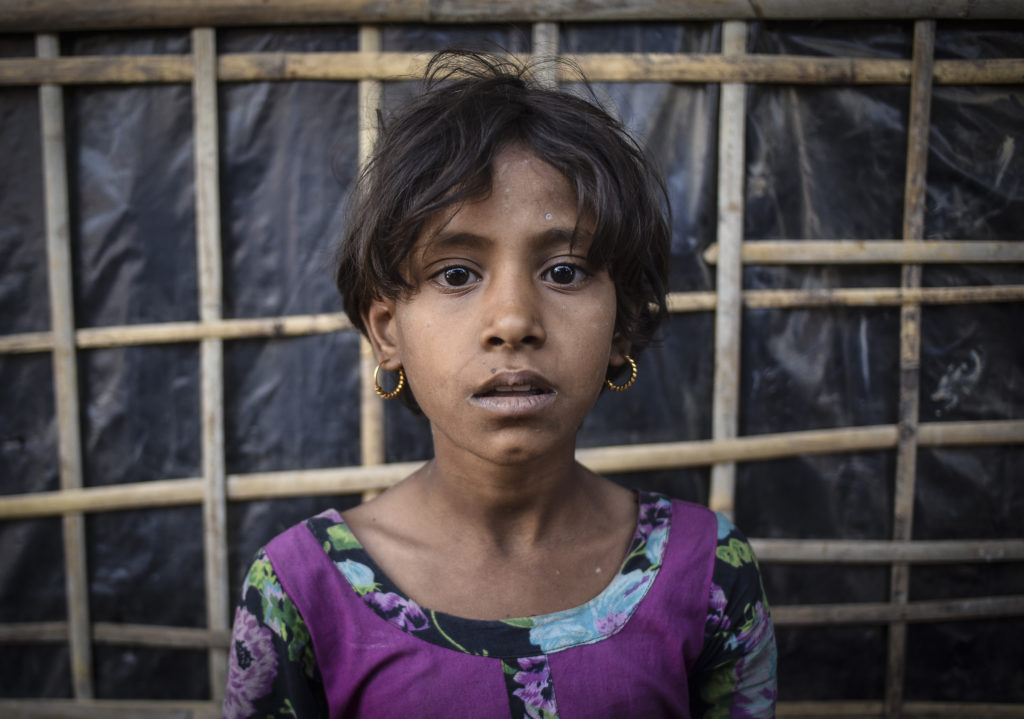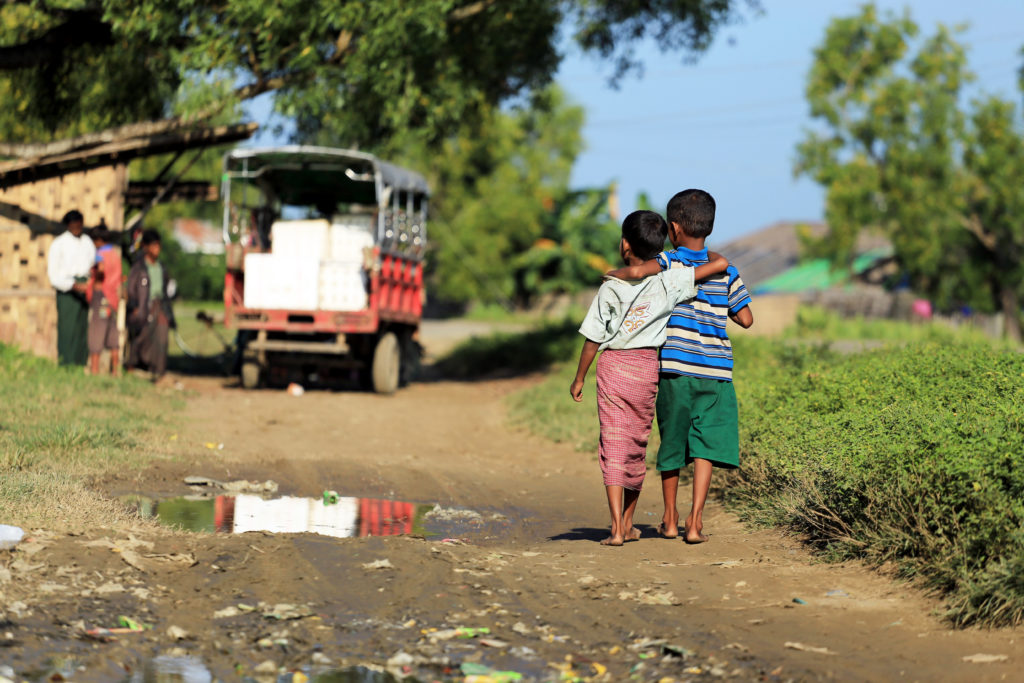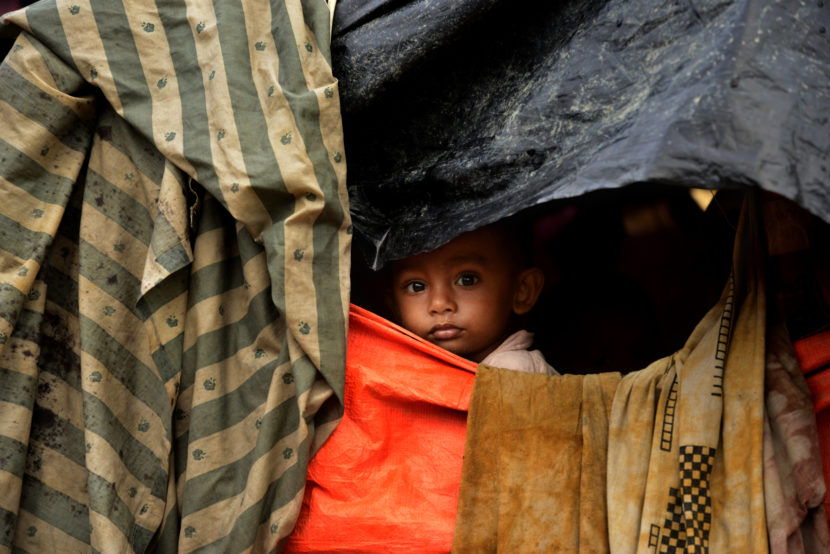The Rohingyas are among the world’s most persecuted minorities. The long-standing discrimination and escalating brutality in Myanmar have been depriving the Rohingyas of the enjoyment of a humane and safe life, for decades. Those who are extremely vulnerable to such abuses are precisely the children from this minority group. Furthermore, the Rohingyas also face an inhospitable and unsanitary environment in Bangladesh, which is stripping the Rohingyas children, faced already with statelessness, mistreatment and exodus, of their basic human rights.
The Rohingyas: a community of Muslims in Myanmar
The Rohingyas are a group of individuals, of the Muslim religion, generally concentrated in the Rakhine State in Myanmar (Encyclopeadia Britannica, 2023). The Rohingya community is considered a minority in Myanmar and constitutes around one-third of the Buddhist majority population in Rakhine State (Encyclopeadia Britannica, 2023). The Rohingyas speak “Rohingya or Ruaingga, a dialect that is distinct to others spoken throughout Myanmar” (Al Jazeera, 2018).
The Rohingyas’ “distinct ethnic, cultural, and linguistic community” can be traced to the late 7th century (Encyclopeadia Britannica, 2023). Indeed, the Rohingya people stated that “they are descendants of Muslims, perhaps Persian and Arab traders, who came to Myanmar generations ago” (The Guardian, 2017).
A brief review of the Rohingyas history
The refusal of Myanmar to recognize the existence of the Rohingyas has its “roots in Britain’s colonization of Burma”, a former province under British rule, which now constitutes the country of Myanmar (National Geographic, 2019). During this period, a considerable amount of “migration of laborers to Burma from neighbouring South Asia” occurred, which was considered an internal movement by the British administration (Human Rights Watch, 2000). At the time, this “migration of labourers was viewed negatively by the majority of the native population” of Burma (current Myanmar) (Al Jazeera, 2018).
Following the independence of Myanmar from British ruling, the government viewed the migration that occurred during British ruling as “illegal”, and on this basis, Myanmar refused “citizenship to the majority of Rohingya” (Human Rights Watch, 2000). For this reason, the Rohingyas are perceived by many in Myanmar “as illegal immigrants” and consequently, they suffer from “systematic discrimination” (The Guardian, 2017).
In 1948, the government of Myanmar passed the Union Citizenship Act, “defining which ethnicities could gain citizenship” (Al Jazeera, 2018). The Rohingyas were not included as an ethnicity to benefit from this Act (Allard K. Lowenstein International Human Rights Clinic – Yale Law School, 2015). The Rohingyas could still apply for identity cards under the former regime (Al Jazeera, 2018). However, after the 1962 military coup in Myanmar, which lead to a Military Dictatorship, the livelihoods of the Rohingyas changed drastically (Kipgen, 2011; Al Jazeera, 2018).
Subsequently, “all citizens were required to obtain national registration cards” and the Rohingya “were only given foreign identity cards” (Al Jazeera, 2018). More drastically, a new citizenship law was passed in 1982 and the Rohingyas were “not recognised as one of the country’s 135 ethnic groups” in Myanmar (Al Jazeera, 2018). In view of the fact that a stateless person is defined as “someone who is not recognised as a citizen under the laws of any country, which means, simply, that they hold no nationality”, and in view of the above-mentioned enacted law by Myanmar, the Rohingyas were rendered stateless (Médecins Sans Frontières, 2022).
The Rohingyas as a stateless and persecuted population in Myanmar
Given the above-mentioned denial of essential paperwork, i.e., an identification card or citizenship, the rights of the Rohingyas to vote, “study, work, travel, marry, practice their religion and access health services” are effectively affected and restricted (Al Jazeera, 2018). Concretely, it has been estimated that “447,000 (Rohingyas) live in villages where they have little freedom of movement” (UNHCR – The UN Refugee Agency, 2022).
The Rohingya children suffer from various consequences due to their stateless status. First and foremost, they have difficulties accessing education, either due to explicit discriminatory rules “which exclude them from school”, or due to policies “that should enable them to go to school” which are not enforced (Save the Children, 2021). Furthermore, they have “very limited access to health care in Myanmar, and the majority did not receive routine vaccinations” and “this makes them highly vulnerable to preventable diseases” (Médecins sans Frontières, 2018).
In addition, “financial pressures and cultural attitudes about girls’ education mean Rohingya adolescent girls are even less likely to go to school, and more likely to be married off early” (Save the Children, 2021). Stemming from the discrimination they suffer from, the Rohingyas children face the risk of “arrest and detention and “confinement in immigration detention centres and refugee camps” (Save the Children, 2021).

Likewise, without the possession of legal identity documents, the children “are at the mercy of traffickers and drug dealers” (UN News, 2019). This discrimination can moreover be “circulated online and in media by state officials, which threatens children’s safety” (Save the Children, 2021).
Already in April 2013, Human Rights Watch warned the world that Myanmar was “conducting a campaign of ethnic cleansing against the Rohingya” (Human Rights Watch, 2013). The Rohingya who have remained in Rakhine State are facing “systematic abuses that amount to the crimes against humanity of apartheid, persecution, and deprivation of liberty” (Human Rights Watch, 2022).
The government of Myanmar, to this day, “repeatedly rejected accusations of abuses” committed against the Rohingyas on its territory (Al Jazeera, 2018). Ever since 2017, “more than one million Rohingya refugees, half of whom are children, have lived in cramped camps after being violently forced from their homes across the border in Myanmar to escape unimaginable violence” (Save the Children, n.d.).
The Rohingyas children seeking refuge in Bangladesh
The Rohingyas have been forced to flee to neighbouring countries, ever since the late 1970s (Al Jazeera, 2018). However, this movement was aggravated due to the recent widespread, governmental violence and persecution committed against the Rohingyas.
Over 700,000 Rohingyas have embarked on a dangerous journey at sea, from which many – including children – have lost their lives, in order to reach Bangladesh (Save the Children, n.d.; UNHCR – The UN Refugee Agency, 2022). The reality is that 55% of Rohingyas refugees are “younger than 18 years of age”, and that in Bangladesh, “over 450,000 Rohingya refugees” are children (UNHCR – The UN Refugee Agency, n.d.; Save the Children, n.d.).
“Many Rohingya refugee children in Bangladesh have witnessed atrocities in Myanmar no child should ever see, and all have suffered tremendous loss.”
– Anthony Lake, UNICEF Executive Director (UNICEF, 2017)
Having reached their destination in Bangladesh in the hope of finding a safe haven, the Rohingyas and their children are, again, faced with similar difficulties to those in Myanmar. The Rohingyas are being crammed and placed in shelters situated in refugee camps, which are highly unsanitary (Médecins Sans Frontières, 2020).
This causes the Rohingyas to be more prone to catch illnesses and diseases and puts Rohingya children particularly at risk (Médecins Sans Frontières, 2020; UNCHR – The UN Refugee Agency, 2022). To make it even worse, uncontrollable fires and the heavy rainfall of the monsoon render the living situation in these camps to be unbearable and highly hazardous (The Guardian, 2022; UNCHR – The UN Refugee Agency, 2022).
In addition, Rohingya children are not registered when they are born in refugee camps and are not provided with a legal identity, or refugee status (UNICEF, 2019). This continued lack of identification hinders the basic human rights of Rohingya children, such as access to education and to health services.
Furthermore, the Bangladeshi Police are targeting and committing assaults, “extortion, arbitrary arrests, and harassment” on the Rohingya refugees (Human Rights Watch, 2023) which falls in line with Bangladesh’s inability to handle the refugee crisis and its inhospitable policy to induce the repatriation of Rohingyas refugees to Myanmar (Aljazeera, 2022).
An international call for action
The constant persecution and discrimination suffered by the Rohingyas and their children, leading to recounted acts of violence and alarming accounts of child deaths, surpassed with the current refugee crisis, places the Rohingyas, and one of its most vulnerable groups, its children, in a situation calling for immediate action and remedy.
For this reason, Humanium calls onto the government of Myanmar, as a matter of priority, to “immediately amend its discriminatory 1982 Citizenship Law” in order to finally provide the Rohingyas equal access to Myanmar citizenship and to ensure the security of the Rohingyas “from abusive security forces and other groups” (Human Rights Watch, 2022).
For the sake of the Rohingyas and their children currently facing hardship in Bangladesh, Humanium calls on the government of Bangladesh to uphold its “responsibility under international human rights law to ensure that the rights of everyone in its jurisdiction, including refugees, are protected, and to investigate allegations of abuses by government security forces and hold those responsible to account” (Human Rights Watch, 2023).

Humanium remains committed to safeguarding children’s human rights, including their rights to life, education and health. If you want to contribute to Humanium’s cause, please consider making a donation, volunteering or becoming a member.
Written by Moïra Phuöng Van de Poël
Bibliography:
Al Jazeera. (2018, April 18). Who are the Rohingya? – The more than one million Rohingya Muslims are described as the ‘world’s most persecuted minority’. Retrieved from Al Jazeera at https://www.aljazeera.com/features/2018/4/18/who-are-the-rohingya, accessed in March 2023.
Aljazeera. (2022, August 2017). Bangladesh tells UN that Rohingya refugees must return to Myanmar. Retrieved from Aljazeera at https://www.aljazeera.com/news/2022/8/17/rohingya-refugees-have-to-be-taken-back-bangladesh-pm-says, accessed in March 2023.
Allard K. Lowenstein International Human Rights Clinic – Yale Law School. (2015, October). Persecution of the Rohingya Muslims: Is Genocide occuring in Myanmar’s Rakhine State ? A legal analysis. Retrieved from Allard K. Lowenstein International Human Rights Clinic – Yale Law School at http://www.fortifyrights.org/downloads/Yale_Persecution_of_the_Rohingya_October_2015.pdf, accessed in March 2023.
Encyclopeadia Britannica. (2023, March 5). Topic – Rohingya. Retrieved from Encyclopeadia Britannica at https://www.britannica.com/topic/Rohingya, accessed in March 2023.
Human Rights Watch. (2013, April 22). All You Can Do is Pray: Crimes Against Humanity and Ethnic Cleansing of Rohingya Muslims in Burma’s Arakan State. Retrieved from Human Rights Watch at https://www.hrw.org/report/2013/04/22/all-you-can-do-pray/crimes-against-humanity-and-ethnic-cleansing-rohingya-muslims, accessed in March 2023.
Human Rights Watch. (2023, January 17). Bangladesh: Rampant Police Abuse of Rohingya Refugees. Retrieved from Human Rights Watch at https://www.hrw.org/news/2023/01/17/bangladesh-rampant-police-abuse-rohingya-refugees, accessed in March 2023.
Human Rights Watch. (2000, May). Historical Background of Burma. Retrieved from Human Rights Watch at https://www.hrw.org/reports/2000/burma/burm005-01.htm, accessed in March 2023.
Human Rights Watch. (2022, August 19). Myanmar: Crimes Against Rohingya Go Unpunished. Retrieved from Human Rights Watch at https://www.hrw.org/news/2019/08/22/myanmar-crimes-against-rohingya-go-unpunished, accessed in March 2023.
Human Rights Watch. (2022, August 24). Myanmar: No Justice, No Freedom for Rohingya 5 Years On. Retrieved from Human Rights Watch at https://www.hrw.org/news/2022/08/24/myanmar-no-justice-no-freedom-rohingya-5-years#:~:text=Rohingya%20are%20effectively%20denied%20citizenship,repression%2C%20discrimination%2C%20and%20violence, accessed in March 2023.
Kipgen, N. (2011, May 14). Journal Article – Political Change in Burma: Transition from Democracy to Military Dictatorship (1948-62). Retrieved from JSTOR at https://www.jstor.org/stable/23018213, accessed in March 2023.
Médecins Sans Frontières. (2017, December 12). MSF surveys estimate that at least 6,700 Rohingya were killed during the attacks in Myanmar. Retrieved from Médecins Sans Frontières at https://www.msf.org/myanmarbangladesh-msf-surveys-estimate-least-6700-rohingya-were-killed-during-attacks-myanmar, accessed in March 2023.
Médecins Sans Frontières. (2020, August 25). Rohingya refugees remain in limbo three years after mass exodus. Retrieved from Médecins Sans Frontières at https://www.msf.org/rohingya-bangladesh-remain-limbo-three-years, accessed in March 2023.
Médecins Sans Frontières. (2022, August 22). Stories from Patients and Staff – What is Stateless? Retrieved from Médecins Sans Frontières at https://msf.org.au/article/stories-patients-staff/what-statelessness, accessed in March 2023.
Médecins sans Frontières. (2018, March 15). What is the Rohingya refugee crisis? Retrieved from Médecins sans Frontières at https://www.doctorswithoutborders.org/what-we-do/focus/rohingya-refugee-crisis, accessed in March 2023.
National Geographic. (2019, February 9). Who are the Rohingya people? Retrieved from National Geographic at https://www.nationalgeographic.com/culture/article/rohingya-people, accessed in March 2023.
Save the Children. (n.d.). Emergency Response – The Rohingya Crisis: Explained. Retrieved from Save the Children at https://www.savethechildren.org/us/what-we-do/emergency-response/rohingya-crisis#start, accessed in March 2023.
Save the Children. (2021, June 17). Stranded, Stateless, Detained: New report reveals 700,000 Rohingya children are denied basic rights accross Asia. Retrieved from Save the Children at https://www.savethechildren.net/news/stranded-stateless-detained-new-report-reveals-700000-rohingya-children-are-denied-basic-rights, accessed in March 2023.
The Guardian. (2017, September 6). Who are the Rohingya and what is happening in Myanmar? Retrieved from The Guardian at https://www.theguardian.com/global-development/2017/sep/06/who-are-the-rohingya-and-what-is-happening-in-myanmar, accessed in March 2023.
The Guardian. (2022, August 23). ‘Like an open prison’: a million Rohingya refugees still in Bangladesh camps five years after crisis. Retrieved from The Guardian at https://www.theguardian.com/global-development/2022/aug/23/five-years-rohingya-refugees-2017-bangladesh-myanmar-military-crackdown, accessed in March 2023.
UN News. (2019, February 27). Migrants and Refugees – Stateless Rohingya refugee children living in ‘untenable situation’. Retrieved from UN News at https://news.un.org/en/story/2019/02/1033722, accessed in March 2023.
UNCHR – The UN Refugee Agency. (2022, July 13). Rohingya Refugee Crisis Explained. Retrieved from UNCHR – The UN Refugee Agency at https://www.unrefugees.org/news/rohingya-refugee-crisis-explained/#Fires, accessed in March 2023.
UNHCR – The UN Refugee Agency. (n.d.). News – Rohingya children: a generation at risk. Retrieved from UNHCR – The UN Refugee Agency at https://www.unrefugees.org/news/rohingya-children-a-generation-at-risk/, accessed in March 2023.
UNHCR – The UN Refugee Agency. (2022, August 25). News Stories – Stateless Rohingya continue to struggle for survival in Myanmar. Retrieved from UNHCR – The UN Refugee Agency at https://www.unhcr.org/news/stories/2022/8/630780aa4/stateless-rohingya-continue-struggle-survival-myanmar.html, accessed in March 2023.
UNHCR – The UN Refugee Agency. (2022, May 23). UNHCR shocked at Rohingya deaths in boat tragedy off Myanmar coast. Retrieved from UNHCR – The UN Refugee Agency at https://www.unhcr.org/news/press/2022/5/628b77184/unhcr-shocked-rohingya-deaths-boat-tragedy-myanmar-coast.html, accessed in March 2023.
UNICEF. (2019, February 27). 18 months after exodus from Myanmar, Rohingya children at a crossroads. Retrieved from UNICEF at https://www.unicef.org/rosa/press-releases/18-months-after-exodus-myanmar-rohingya-children-crossroads, accessed in March 2023.
UNICEF. (2017, October 20). Press release – Violence in Myanmar driving up to 12,000 Rohingya refugee children into Bangladesh every week. Retrieved from UNICEF at https://www.unicef.org/press-releases/violence-myanmar-driving-12000-rohingya-refugee-children-bangladesh-every-week, accessed in March 2023.
United Nations Office of the High Commissioner. (2022, June 29). Myanmar: Crisis taking an enormous toll on children, UN committee warns. Retrieved from United Nations Office of the High Commissioner at https://www.ohchr.org/en/statements/2022/06/myanmar-crisis-taking-enormous-toll-children-un-committee-warns, accessed in March 2023.
United Nations Office of the High Commissionner. (2019, September 16). Press release – Myanmar’s Rohingya Persecuted, Living under Threat of Genocide, UN Experts Say. Retrieved from United Nations Office of the High Commissionner at https://www.ohchr.org/en/press-releases/2019/09/myanmars-rohingya-persecuted-living-under-threat-genocide-un-experts-say?LangID=E&NewsID=24991, accessed in March 2023.


